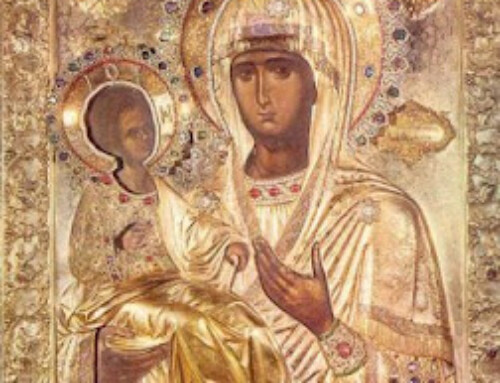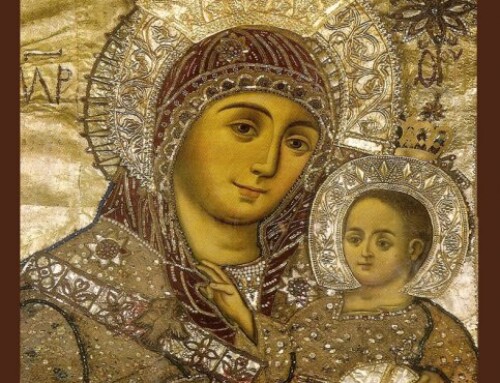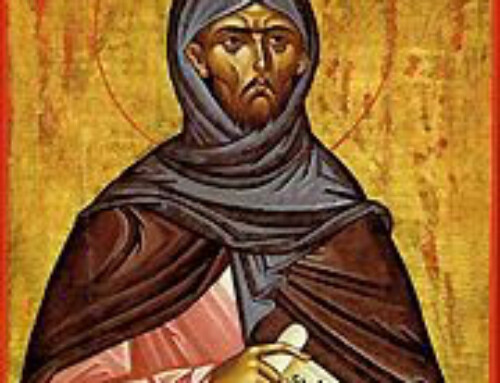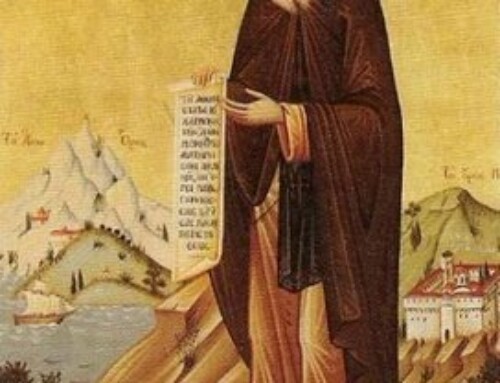 September 26th The Repose of the Apostle and Evangelist John The Theologian
September 26th The Repose of the Apostle and Evangelist John The Theologian
He was a humble Palestinian fisherman who earned a living by casting his nets daily into mighty Lake Gennesareth (also known as the Sea of Galilee). And it was here, on the shores of the windblown lake, that St. John the Theologian – along with his older brother, James – would be converted to the Gospel of Jesus Christ. After listening to the Holy Redeemer preach on the subject of “loving God and loving thy neighbor,” St. John would leave his father behind and become one of Our Savior’s most beloved apostles. He would also go on to spend many years making converts and performing miracles . . . until settling down to write the fourth and final Gospel of the New Testament.
In the days before the Crucifixion of Christ, John and James followed Him throughout Palestine, where he preached the Word and healed the sick. On one particularly dramatic occasion, John watched in awe as the Son of God resuscitated the daughter of Jairus, who had died in front of her grieving father. John also witnessed the extraordinary Transfiguration of Christ atop Mt. Tabor.
The son of Zebedee and Salomia (a daughter of St. Joseph the Betrothed), St. John was the youngest apostle, and also one of the Lord’s favorites. Their closeness can be observed in the fact that St. John sat next to Jesus at the Last Supper, where he beseeched the Lord to tell him the name of the disciple (Judas) who would soon betray the Savior. A few hours later, this loyal disciple (sometimes called the “Apostle of Love”) followed his teacher on the torturous journey from the Garden of Gethsemane to the Jerusalem court of the Jewish high priests, Annas and Caiphas, where the Savior would be interrogated mercilessly and then condemned to death.
After the sentencing, St. John followed in the Lord’s footsteps along the agonizing Way of the Cross. As the Lord hung from it, he turned his head toward his mother and informed her that St. John would now be her protector, while uttering the unforgettable words: “Woman, behold your son!” (John 19:26) To St. John, he then proclaimed: “Behold your mother!” (John 19:27) And from that moment on, it was understood that The Blessed Ever Virgin and Theotokos, Mary, had been entrusted to the care of this faithful servant.
the Cross. As the Lord hung from it, he turned his head toward his mother and informed her that St. John would now be her protector, while uttering the unforgettable words: “Woman, behold your son!” (John 19:26) To St. John, he then proclaimed: “Behold your mother!” (John 19:27) And from that moment on, it was understood that The Blessed Ever Virgin and Theotokos, Mary, had been entrusted to the care of this faithful servant.
After Mary’s own passing a few years later, St. John set off to preach the Gospel in Ephesus (a Greek city in Asia Minor, now part of modern Turkey), where he eventually became bishop. He also preached in several other cities in Asia Minor, usually accompanied by his own loyal disciple, a devoted youth named Prokhoros. Their friendship would last many years, and was marked by an extraordinary miracle in which they were shipwrecked together.
Prokhoros managed to survive the disaster, and made it back to dry land. But he wept bitter tears when St. John did not appear. Apparently, the great disciple had been drowned at sea. Fourteen days later, however, as he traveled along the coastline toward Ephesus, Prokhoros was stunned to see St. John emerge dripping from the water, safe and unharmed! The two of them continued their journey and then spent many years preaching the Word and healing the sick throughout the Holy Land.
Their troubles were only beginning, however. With the arrival of Nero (54-68) as Roman emperor, a campaign of violent persecution of the Christians got underway throughout the Roman Empire. St. John was quickly arrested and transported to Rome for trial on charges of sedition, because of his passionate preaching of the Gospel. Convicted and sentenced to die, he was given a tankard of poison . . . but amazed his executioners by drinking the entire potion without being in the least harmed.
Undaunted, the execution squad threw the steadfast Christian into a great cauldron of boiling oil. But once again, Providence intervened – and St. John stepped out of the sizzling vessel without the slightest injury. Frustrated by their inability to destroy the saint, his persecutors finally shipped him off to perpetual imprisonment on the distant Greek island of Patmos.
No sooner had he landed, however, than this dedicated Christian apostle once again began teaching the Gospel to everyone who would listen. In the end, he would spend many years wandering the isle . . . while casting out devils, healing the sick, and converting hundreds of islanders to Christianity. During these fruitful travels, he often encountered – and defeated – the famed chief sorcerer of Patmos, the magician Kinops, who did his best to destroy the saint with his occult powers but always failed.
After Kinops had been vanquished, John retreated with Prokhoros to a windblown mountain crag, where he began a self-imposed fast. As he prayed steadily, a great earthquake rocked the landscape and thunder crashed in terrifying reverberations upon the earth. Stricken with fear, Prokhoros fell face-down on the heaving ground . . . but St. John quickly pulled him to his feet and asked him to write down a profoundly eloquent message that had arrived with the storm.
Prokhoros did as instructed, and quickly wrote out the following declaration from the Beyond: “I am the Alpha and the Omega, the Beginning and the End,” says the Lord, “who is and who was and who is to come, the Almighty.” (Revelation 1: 8) With these words, written in 67 A.D., John would set down the opening lines of the Book of Revelation. Years later, when he was finally released and had returned to his duties as Bishop of Ephesus, he would finish this vividly written book of mystical prophecy at age 95.
St. John lived to be more than 100 years old, and just before dying, he requested that he be interred in a cross-shaped grave. His wishes were honored, and the gravesite became a famed regional landmark where many unbelievers were later converted. In addition, many visitors to the gravesite on the anniversary of St. John’s death each year were healed of sicknesses by a fine dust that mysteriously arose from the burial site and blew over them.
Known as the “Beloved Apostle” – and also referred to by Christ as a “Son of Thunder” – this extraordinary man was the only one of the original disciples to die a natural death. But his final years were full of peace and kindness to others. One beautiful Church tradition, in particular, captures the essence of St. John’s loving nature. According to this legend, the saint became so frail and weak near the end of his life that he had to be carried to the local church for services – during which he would always restrict himself to a single admonition: “Little children, love one another!”
After hearing this advice over and over again, several members of the congregation asked St. John: “Master, why do you always say this?” He replied with a gentle smile: “It is the Lord’s command. And if this alone be done, it is enough!”
St. John’s life provides a compelling example of the way in which a faithful follower of Christ can use his own natural gifts for the greater glory of God. A skilled speaker, St. John was enormously effective at spreading the Gospel, and became one of the most powerful preachers among the early Christians. A talented and poetic writer, he also used his ability with the pen to craft one of the great documents of mankind, the Fourth Gospel.
Firm and steadfast in his faith to the end, St John remains an inspiration to all those who yearn to spread the Gospel of Jesus Christ throughout the world. John’s Gospel shows us Jesus, both fully divine and fully human. John was a man who loved Jesus deeply, but he was also very much a human being – with both the strengths and the weaknesses shared by all of us. Perhaps this is why he is sometimes regarded as the favorite of all the Gospel writers.
Apolytikion in the Second Tone
O Apostle, beloved of Christ our God, hasten to deliver a defenceless people. He that allowed thee to recline on His breast, receiveth thee bowing in intercession. Implore Him, O Theologian, to dispel the persistent cloud of the heathen, and ask for us His peace and great mercy.
Kontakion in the Second Tone
Who can tell thy mighty works, O virgin Saint? For thou pourest forth miracles, and art a source of healings, and thou dost intercede for our souls, as the Theologian and the friend of Christ.





